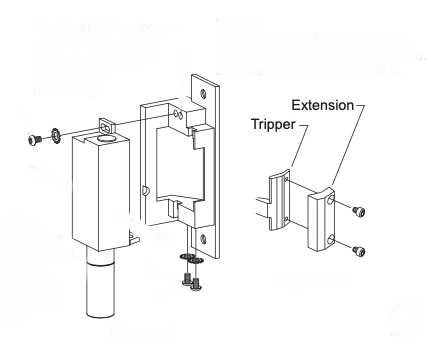
From Von Duprin 6211 installation instructions.
LBM stands for Latch Bolt Monitor. LBSM stands for Latch Bolt and Strike Monitor, also known as LBCM and DS, depending on the manufacturer. There are probably other variations as well.
In the illustration above is shown the Von Duprin 6211. The labeled parts, “Tripper” and “Extension,” are used when the strike is equipped with the DS (dual switch) option. The DS option is Von Duprins version of LBSM. The Tripper is a piece of metal that changes the state of a switch when it is depressed by the spring-loaded force of a latch bolt when it drops into the keeper. Most other strikes use similar mechanisms to detect the presence of the latch bolt.
LBM will tell you if there is not a latch bolt present in the keeper. LBSM will tell you if there is no latch bolt present in the keeper and/or the strike itself is not in the fully locked position. Neither of these would tell you if the door is ajar. So LBM and LBSM are not true substitutes for a door position switch.
And, if someone stuffs the keeper with something to effectively keep the door unlocked or fool it into thinking there was a latch bolt there, it won’t tell you anything. On the other hand, if you don’t have LBM, someone can tape the latch back with duct tape you would have no way of knowing. The door position switch will tell you the door is closed, but you need the LBM to tell you it’s latched. The LBSM can provide you with the additional information that the electric strike is not properly locked; perhaps the keeper is not closed all the way or the internal parts are not all the way in the locked position.
access control, electric locking, electric strike, security harware

{ Comments are closed! }